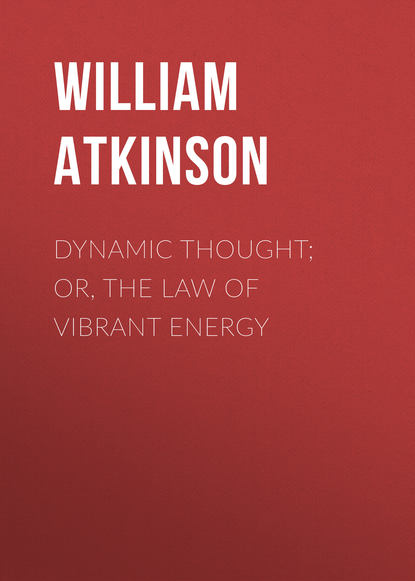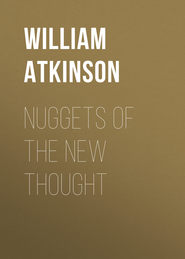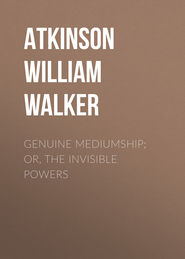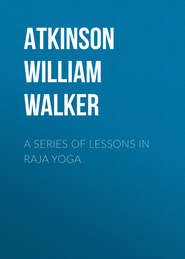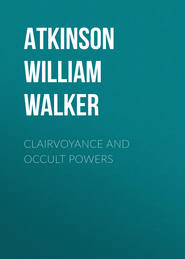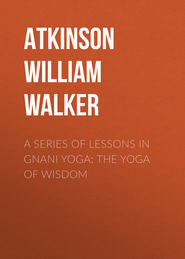По всем вопросам обращайтесь на: info@litportal.ru
(©) 2003-2024.
✖
Dynamic Thought; Or, The Law of Vibrant Energy
Настройки чтения
Размер шрифта
Высота строк
Поля
There is no rest in the world of Substance. Everything is changing – constantly changing. Old forms give way to new, and these, grown old while being born, are, in turn replaced by still newer. And on, endlessly. Nothing persists but change. And yet nothing is destroyed, although countless forms and shapes have succeeded each other. Substance is always there, undisturbed and unaffected by the varieties of forms it is compelled to undergo. Masses may change – and do change. Molecules may change – and do change. Disintegration and decomposition affect both, and bring to them the death of form. But their substance endures in the Atom. Atoms may change, and decompose, or undergo whatever change that is their fate, and still the Corpuscles, or what lies beyond the Corpuscles will remain. The Atom was once regarded as Eternal, but now even it seems to be capable of dissolving into some finer division of Substance – and perhaps still finer subdivisions await it.
That familiar form of Substance that we call "earth," "dirt," "soil," etc., is but the result of disintegrated rock, which has crumbled and lost its former form through the action of air, water and atmospheric influences. And the rocks themselves, from which the "soil" came, were at one time a sea of melted, flowing liquid Substance, somewhat resembling volcanic lava. And this "melted rock" is thought to have been condensed from the same principles in the shape of vapor, that existed in the early days of our planetary system. Vapor, gas, liquid, semi-liquid, solid rock, "soil" – the Substance unchanged, the forms totally unlike. Helmholtz estimates the density of the nebulous vapors of Substance as being so rare that it would take several millions of cubic miles of it to weigh a single grain. Oh, Nature, what a wizard thou art!
We have spoken of Air and Water, in a former chapter, and their constituent atoms have been named. And from these three great reservoirs of Substance – the Earth, the Air, and the Water – are obtained all the material that goes to form the bodies of the animal and vegetable kingdoms. The plant draws its nourishment from the soil, the air, and water, and in its wonderful chemical laboratory is able to transform the elements so drawn from these sources into a substance called "Plasm," which consists principally of carbon, oxygen, nitrogen and hydrogen, being nearly identical in composition to the white of an egg, and which constitutes the basis of animal and plant bodily structures. All the material of the physical bodies, of men, animals and plants, are but forms of Plasm. The animals, and man, obtain their nourishment, directly or indirectly, from the plant body, and so at the last we are seen to draw from the soil, air and water all our bodily nourishment, which we convert into bodily structure, bone, muscle, flesh, blood, veins, tissue, cells, etc. And the chemical atoms of our bodies are identical with those in the rock, the air, the water. And so you see the universality of Substance and its countless forms and appearances.
Chemistry resolves Substance back into about seventy-five simple substances, of which Atoms are the Units, which simple substances are called "Elements." From these Elements (by their Atoms) all other substances are formed by combinations, the number of such possible combinations being infinite. An Element (in order to be an element) must be a "simple" substance, that is, must be incapable of further analysis into some other elements. The seventy-five elements, now recognized by science, have never been resolved into other elements, by chemical analysis, and therefore are accepted as "simple." But, it is true that other substances that were formerly considered as simple elements were afterward decomposed by electricity, and found to consist of two or more simpler substances or elements. Thus new elements were discovered, and old ones discarded as "not-elemental." And this fate may be in store for a number of the elements now on the list – and many new ones may be discovered.
For a long time Science was endeavoring to trace all elements back to Hydrogen, the latter being considered the "Ultimate Element," and its atoms composing all the other atoms, under varying conditions, etc. But this theory is now almost abandoned, and Science rests on its list of seventy-five elements, the atoms of which are composed of "Electrons." Some have hazarded the theory that the Elements were all forms of Ether (see next chapter), their apparent differences resulting merely from the varying rate of vibration, etc. And, in fact, such theory was about finally adopted as a working hypothesis until the discovery of the Corpuscle. Everything in Substance now seems to be moving back to the Corpuscle, as we shall see a little further on.
The following is a list of the principal Elements, known to Science, to-day:
Aluminum.
Antimony.
Arsenic.
Barium.
Bismuth.
Boron.
Bromine.
Cadmium.
Calcium.
Carbon.
Chlorine.
Chromium.
Cobalt.
Copper.
Fluorine.
Gold.
Hydrogen.
Iodine.
Iron.
Lead.
Magnesium.
Manganese.
Mercury.
Nickel.
Nitrogen.
Oxygen.
Phosphorus.
Platinum.
Potassium.
Radium.
Silicon.
Silver.
Sodium.
Strontium.
Sulphur.
Tin.
Zinc.
Of the above, Hydrogen is by far the lightest in weight; in fact it is used as a unit of Atomic Weight, its weight being marked "1" on the scale; Gold, 197; Lead, 207; Silver, 108; Oxygen, 16; Nitrogen, 14; Iron, 56.
The discovery of the Corpuscle, or Electron, rudely shattered the vortex-ring theory of the origin of the Atom, and now, instead of the Atom being regarded as a "vortex-ring" in that hypothetical, paradoxical absurdity, the Ether, it is believed to be composed of a vast number of tiny particles called Corpuscles, as we saw stated in our last chapter. These Corpuscles seem to be the "last thing in Substance" – its last known state of refinement, and already it is being proclaimed as the long-sought for "Primal Matter," or "Ultimate Substance." Whether or not a still finer state of Substance will be discovered Science is unable to say, but thinks it unlikely. But we must not overlook the old Occult Teaching indicating a state of Substance so fine that it is imperceptible, and only recognizable as apparently "free force"; its covering, or vehicle of Substance not being evident. This would seem to indicate a still further refinement of Substance, although perhaps the "Corpuscle" or "Electron" will answer to "fill the bill" in the case.
As to the Corpuscle being "Primal Substance," it must be admitted that its advocates have presented a very strong case. One of their most important points is that although Molecules differ very materially from each other, according to their kinds; and while Atoms likewise manifest very plainly their "kind," the Corpuscle seems to possess only one "kind," no matter from what form or "kind" of Substance it is thrown off. Just think what this means. It means that the finest particles of Gold, Silver, Iron, Hydrogen, Oxygen, and all the rest of the Elements, are composed of identically the same material, and exhibit no differences in "kind." The Elements are no longer "Simple." All Substance is One, at the last analysis!
The Corpuscles seem to possess the same Mass – to carry the same charge of Electricity – to act precisely the same – irrespective of their source. No difference in size, mass or character, as in the case of the Atom – all are identical, save in the rate of their vibration at the time of observation, which is simply a matter of more or less Motion. Space seems to be flooded with these tiny particles – these Units of Substance. They stream from the Sun; the Stars; and every body highly heated. Likewise they stream from the bodies of highly electrified Substance. Groups of these Corpuscles, absolutely identical in nature, size, mass, etc., constitute the Atoms of the Seventy-five Elements, the "kind" of Element seemingly being dependent upon the number and arrangement of the Corpuscles, and possibly by their rate of vibration. Every Atom is like a great bee-hive with a swarm of Corpuscles vibrating, moving around each other, and upon their own centres. And, if by the action of intense heat, transmitted, or caused by interrupted Motion – or if by a strong Electric charge – some of these Corpuscles are detached from the Atoms (or possibly an Atom broken up), they fly off through Space at a marvellous speed of many thousand miles an hour.
So we see that these wonderful Corpuscles look very much like Primal Matter or Ultimate Substance – the "Stuff" out of which Substance is made. And, taking you back to the chapter on "The Universality of Life and Mind," the writer would remind you that in their Motions and evident Attraction, etc., these Corpuscles evidence the same "Life and Mind" that we observed in the Molecules and Atoms. It must be so, for what is in the manufactured article must be in the material of which the article is made. And so, even here, Life and Mind have not escaped us. Nor will it in The Ether!
And speaking of the Corpuscles, as "manufactured articles," we are reminded of Herschel's thought about the Atoms, when they were regarded as Primal Matter and likely to be uniform, and, at the end, of one primal substance. Although Herschel's conception does not now apply to the Atoms, it may be transferred to the Corpuscles.
Herschel thought that the fact that the Particles of Substance were likely to be found to be uniform in size, and identical in nature and characteristics, indicated that they might be akin to "manufactured articles," turned out from the same great machinery of Creation. This idea would indicate that the Creator applied the rules of careful manufacture to the manufacture of the Particles, the uniformity operating in the direction of (1) Economy of Material; (2) Utility through interchangeability, replacing broken or discarded parts, etc.; and also (3) Conformity to a Standard of Size, Quality, etc.





